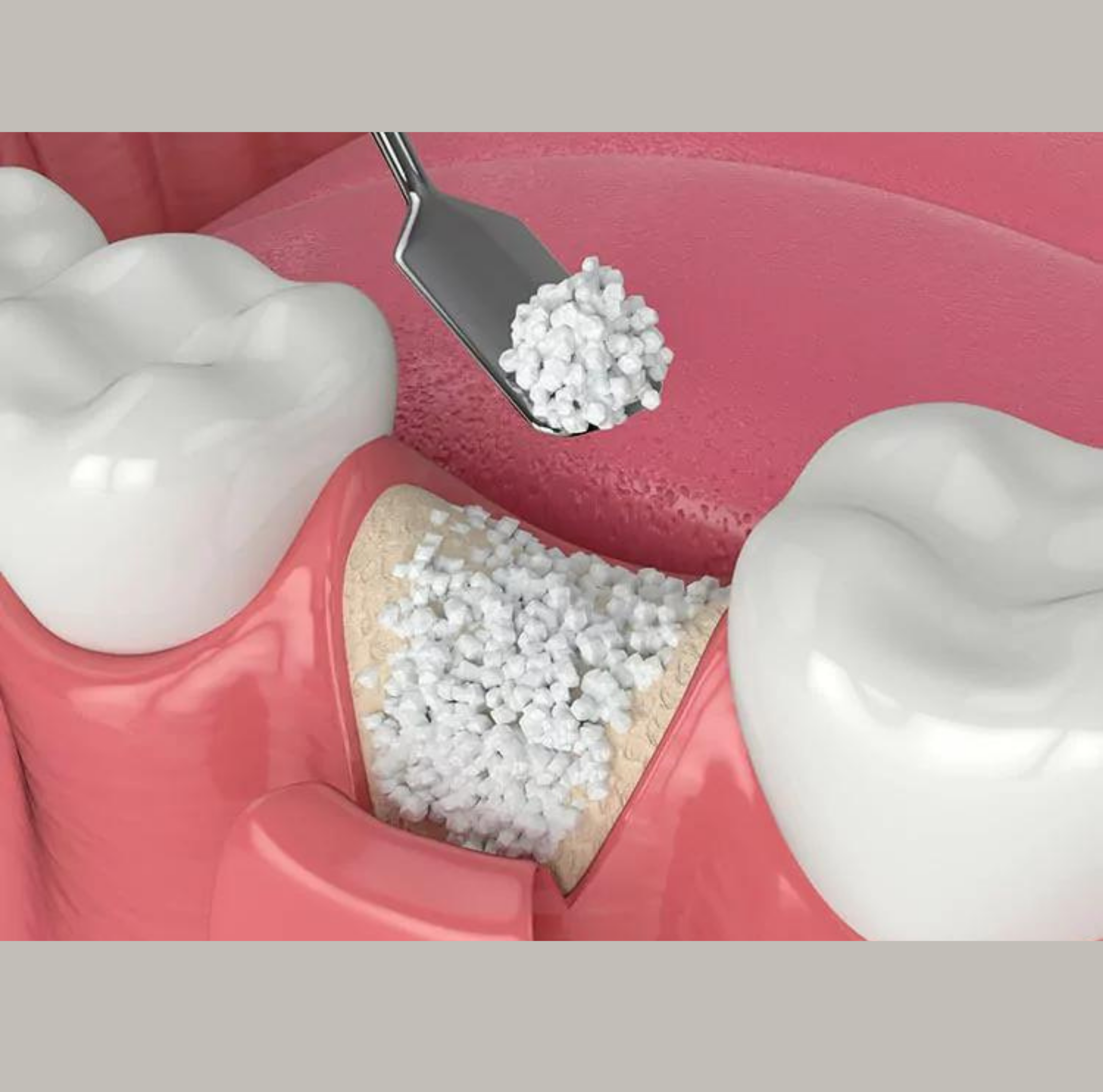what is a dental bone grafting (A Complete Guide)
The dental bone grafting procedure builds up new bone in the jaw that was once used to hold teeth. It is commonly performed before dental implant placement or to increase bone volume in a part of the jaw where the bone has been lost and affecting neighboring teeth or needs additional support.
How does a dental bone graft procedure works?
After the placement of the bone graft, it creates a space for the patient’s own body to do repair work. So we can say, a dental bone graft is similar to a frame on which bone tissue can grow and regenerate.
In some cases, your dentist may combine a dental bone graft with platelet-rich plasma (PRP). It is taken from your blood sample and is used to promote healing and tissue regeneration.
Who can be a good candidate for a dental bone graft procedure?
Anyone with bone loss in his jaw generally needs a bone graft. This procedure may be recommended if you:
- had a tooth extracted.
- You are restoring a missing tooth with a dental implant.
- Requires jaw rebuilding before getting a dental prosthesis.
- Are Having areas of bone loss due to gum (periodontal) disease.
Does bone grafting hurt?
Most people who have dental bone grafts show little to no pain.
A dental bone graft that doesn’t involve picking bone material from a patient’s body is a relatively minor procedure and painless.
But if bone material is obtained from the patient’s body, the recovery can be more painful, as surgery is done in two locations: hip and jaw bone.
The amount of bone that’s picked and then grafted is usually quite small, so the period of discomfort should be brief.
Be sure to take all medications prescribed by the dentist and follow post-operative instructions closely.
How common are dental bone grafting?
Dental bone grafts are an extremely common procedure. They may be performed by a dentist or a specialist, such as a periodontist or an oral maxillofacial surgeon.
How Many Types of dental bone grafting procedures are There?
There are four main types of dental bone grafts, including:
- Socket preservation. This type of graft is called ridge preservation in the socket done immediately after tooth extraction. It fills the space left behind by the missing tooth and prevents the sides of the socket from caving in.
- Ridge augmentation. If the patient has missing teeth for a while, the supporting jawbone becomes thinner than it was earlier. Ridge augmentation increases the jawbone size so it can provide a stable foundation for implants or other restorative options.
- Sinus lift. The maxillary sinuses are sitting just above the upper back teeth. In case of missing upper back teeth, the sinuses may drop down and seize the space once occupied by their roots. You wouldn’t want to place implants in this instance because they would penetrate the sinus membrane. Your oral and maxillofacial Surgeon or periodontist can perform a sinus lift to address this problem. This surgery raises the sinus back to its original position. A dental bone graft is placed underneath the sinus, creating a solid foundation for dental implants.
- Periodontal bone graft. Infection from gum disease can destroy the bone that supports the teeth causing the teeth to lose support. A periodontal bone graft is placed around such a tooth to secure its support and reduce mobility.
- In some cases, bone grafts for dental implants must heal completely before implant placement. Because each patient is unique, recovery times vary. In rare instances, the dentist may be able to place a bone graft and a dental implant simultaneously.
What happens before dental bone graft placement?
The dentist will perform an oral examination to check the health of the teeth, gums, and jaw bone. Dental X-rays or scans are taken to determine the extent of bone loss. Next, the dentist will discuss the treatment options with the patient and create a personalized treatment plan to meet his needs.
How is dental bone graft surgery done?
Here’s how a typical dental bone graft is performed:
1. You’ll receive anesthesia before the procedure, and the dental team will monitor your vital signs.
2. the dental technician will wipe the affected area.
3. Your Surgeon will create an opening in the gums to separate it from the bone where the graft is placed.

4. The Surgeon will then place the bone material between two sections of bone that need to grow together.
5. The bone graft is secured with a dissolvable adhesive material or membrane or special screws.
6. The incision is then sewn up to begin healing.
What happens after a dental bone graft?
You may have pain, swelling, and bruising following a dental bone graft. These are common side effects that should diminish in a few days. The dentist can manage these symptoms with pain killers and antibiotics as well. These should be taken as prescribed.
You might notice small pieces of bone coming out of the area in the first few days. These fragments often feel like grains of sand or salt. This generally isn’t a cause for concern, but visit your dentist to make sure that you’re healing as expected.
Are you put to sleep for a dental bone graft procedure?
Usually, the placement of a bone graft does not require putting the patient to sleep; a dentist can do it easily with local anesthesia. Many dentists offer sedation for your comfort, including nitrous oxide, oral sedation, and IV sedation. If your case is more lengthy, your dentist may suggest general anesthesia. Your dentist will guide you thoroughly on which option is right for you.
How much smoking will ruin a bone graft?
Dental bone grafts have admirably high success rates. However, as with any procedure, failure is possible, especially among people who do smoking or have certain medical conditions. Signs of dental bone graft failure include:
- Worsened pain or swelling after the first week.
- Pus or drainage from the bone graft site.
- Gum recession (when the gums pull away from the teeth).
- No improvement in jawbone volume.
How much is a dental bone graft?
The costs of dental bone grafts can vary greatly. The severity of the procedure and the number of materials used are the two main factors determining the cost.
When bone graft material comes from an external source, the cost can vary between $400 and $1,200. If bone material is picked from your own body, the cost may jump to $2,000 or more.
Many insurance providers do cover dental bone grafts in most medical circumstances.
If the grafting is for cosmetic reasons, you’ll unlikely receive insurance coverage.
How to prepare for a dental bone graft procedure?
You don’t have to do much for a dental bone graft procedure. Here are a few quick steps of what to do before the surgery:
- Avoid eating or drinking 8 to 12 hours before the surgery, depending on the type of sedation you’ll undergo.
- Ask your doctor regarding the medications you use, especially blood thinners, which may raise the risk of bleeding complications during the procedure.
- Make arrangements to arrive home afterward, as you’ll be disoriented after the procedure.
Recovery and aftercare for a dental bone graft
After a dental bone graft, you are likely to leave the dentist’s clinic with a piece of gauze packed around the incision in your mouth.
It would help if you were given instructions for changing the dressing during the next 24 hours and a prescription for antibiotics to help prevent infection. You may also be prescribed pain relievers.
Other post-operative care includes:
- applying ice packs to help minimize the pain and swelling for the first few days
- eating soft, bland foods for the first day or two
- sleeping with your head rather raised the first night or two to help prevent blood from pooling at the site of the surgery
During the initial recovery stage, you should avoid:
- hot liquids, such as tea, coffee, or soup
- hard or crunchy foods, such as nuts
- any physical activity, such as contact sports that may put the incision at risk
After a week or so, soreness in the jaw should only give way to mild discomfort.
- You should start to feel normal after a few weeks. But generally, it takes a few months before your jaw is strong enough.
side effects of a dental bone graft
A dental bone grafting’s most common side effects are pain and swelling.
But these can be reduced to a minimum with ice packs and over-the-counter pain killers. Increasing the dosage of the medications may be necessary for some patients.
Other routine side effects include minor bleeding and difficulty chewing and speaking for the first few days.
Though this procedure is usually safe and well-tolerated, there are always risks.
Infection can occur with any surgical procedure, so it’s extremely important to take the full course of prescribed antibiotics. Other unusual (but serious) side effects include:
- blood clots formation
- nerve damage
- anesthesia complications
- rejection of the bone graft
The Conclusion
Dental bone grafts help prevents long-term health issues like tooth loss and gum disease and provide sufficient bone material to support dental implants.
This common procedure is usually safe and well-tolerated, though there are risks of side effects and complications.

